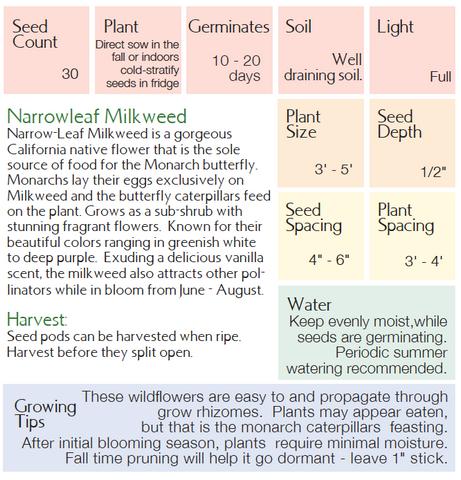
Narrowleaf Milkweed Seeds (Asclepias fascicularis)
Neonicotinoid-Free Non-GMO Narrowleaf Milkweed Seed
Narrowleaf Milkweed is a gorgeous California native flower that is the sole source of food for the Monarch butteries. The butterflies lay their eggs exclusively on Milkweed plants, creating an opportunity for us to plant Monarch habitat!
We recommend planting only milkweed plant that is native to your area. Each region is going to have milkweed specific to its area - except the Pacific Northwest.
Disclaimer: We only ship the appropriate milkweed that is native to your region.
Reasons why planting non-native milkweed is detrimental to the Monarchs:
- In warmer regions, where milkweed does not die back in the winter, a build-up of a debilitating protozoan parasite (Ophryocystis elektroscirrha or OE) that infects monarchs can occur and promote year-round breeding.
- Non-native milkweed presence in the fall could cause migrating monarchs to break diapause (a temporary non-reproductive state) and lay eggs instead of completing their migration to Mexico.
- Reseeding (and invasion) of non-native milkweed species.
Narrowleaf Milkweed grows as a subshrub about 2' - 4' high with stunning fragrant flowers. Known for their beautiful colors ranging in greenish white to deep purple, the Milkweed brings joy and life to every garden! Exuding a delicious vanilla scent, the milkweed also attracts other pollinators while bloom from June - August.
Also known as Mexican Whorled milkweed, this milkweed grows well in dry climates and will blossom from June - September. This beautiful low maintenance, drought tolerant wildflower may be slow to grow the first year, as it sets its taproot deep into the earth. In following years, it will grow more vigorous.
It is very important to plant only locally native milkweed species. Please learn which milkweeds are native to your region and consult this milkweed range maps from the Biota of North America Program’s (BONAP) North American Plant Atlas.
Support the Monarch population by planting your local Milkweed seeds today!
If you live in California, this is the variety we recommend, although, California coastal gardeners check this map and decide if milkweed should be planted in your yard.
Milkweed may not have historically grown in your area. Planting milkweed closer to the coast, may lure Monarchs off of their regular migration pattern. Some Monarchs may not have the resistance to the fungi, created by the moisture in the fog, resulting in caterpillars that are unable to survive.
- Non-GMO
- Perennial
- Sun: Full
- Indoors: 8 weeks before last frost
- Direct Sow: In the fall, or in the spring after cold stratification
- Seed Count: 30
- Plant Size: 3'-5'
- Ornamental
- Attracts pollinators
- Open Pollinated
- Neonicotinoid-free
Growing Tips:
Narrowleaf seeds must be stratified, if they are planted in the spring, for proper germination.
Instructions on cold stratification, to germinate seeds in the spring time.
Place seeds on a damp paper towel. Put the towel and the seeds in a plastic bag and place in a refrigerator for one month. This mimics the natural cold-stratification of planting these native seeds in the fall and having the winter to cold stratify. Make sure the paper towel is kept moist the entire time. After a month, sow the seeds in a warm greenhouse or on a heated mat with a plastic dome. It is important to keep seeds moist while they are growing.. The seeds will appreciate the warmth to properly germinate into strong plants. Narrowleaf planted in the spring will not flower, until the following spring season. This is a slow growing perennial. It will go dormant in the late summer. Once established, it spreads through underground rhizomes.
After the initial blooming season, plants require minimal moisture. Fall time pruning will help it go dormant. Leave 1" stick.
Plants may appear eaten, but that is the monarch caterpillars feasting.
More info on how to create a monarch habitat.

Consider including your garden to the Monarch Joint Venture for their monarch conservation initiatives!
Monarch conservation information – Xerces Society
Report any sightings of Monarchs here.




